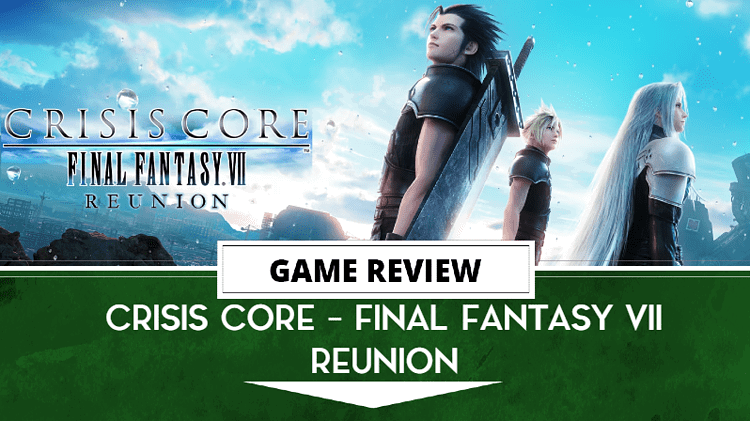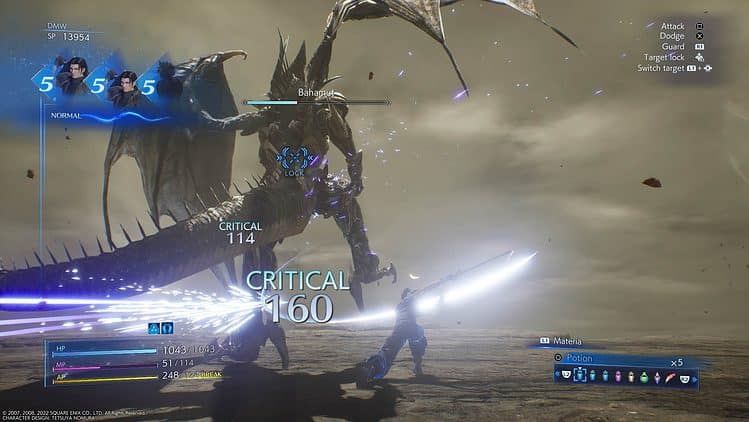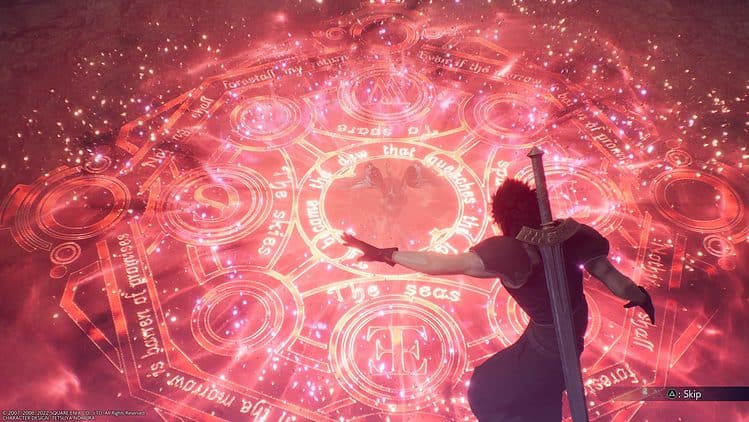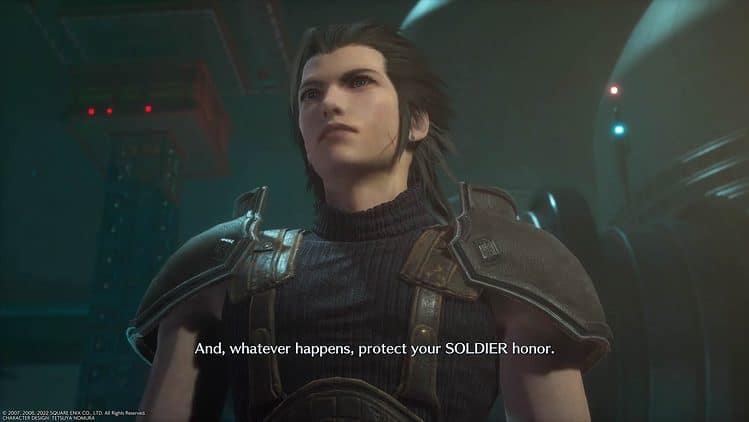I have gone on many tangents in my life, with one of those tangents being talking about Crisis Core on the PSP. Even when you look at my old articles, you may notice I have a bit of a bias toward the game, and I feel that it is one of the best games the PSP has ever had. When Square Enix announced that there was a remaster for the game, I was ecstatic. I wouldn’t shut up about it, and I was excited to get a copy of Crisis Core -Final Fantasy VII- Reunion from Square Enix to review! Let us take a look, shall we?
Game Name: Crisis Core -Final Fantasy VII- Reunion
Platform(s): PS4, PS5(Reviewed), Xbox One, Xbox Series S|X, Nintendo Switch, PC
Publisher(s): Square Enix
Developer(s): Square Enix, TOSE CO., LTD
Release Date: December 12th, 2022
Price: $49.99
Crisis Core – Final Fantasy VII Reunion has a story that honestly holds up well, despite its age (of the original game). The plot of the story can be bonkers, but the best parts are the characters and how they fit in the world of Final Fantasy VII. You play as Zack Fair as he is being mentored by the Soldier first class, Angeal. Soldier is a small but elite fighting force for the Shinra military in Final Fantasy VII — but you already knew that. They range from third class, second class, and first class. Zack Fair wants to be a hero on the level of Sephiroth in Soldier. His time in Soldier gets conflicted as a member named Genesis defects from Soldier and his mentor Angeal defects with him. It is then up to Zack Fair and Sephiroth to figure out what is going on and why anyone would want to leave Soldier.
On the Road to First Class
There is a lot to talk about with the gameplay in Crisis Core – Final Fantasy VII Reunion. You start in a kind of hub where you have access to the briefing room and the Soldier floor of the Shinra building. You do side missions by going to the save point, or you can continue to the main story by going to Director Lazard. Missions usually have a small map that you can travel around with most of them wanting you to beat a monster of some kind somewhere on the map. Fighting enemies for the most part is done through random encounters. As you travel around the mission maps or story maps, you will have a voice speak to you out of nowhere telling you that the combat is about to start. Then you fight all the enemies on screen until the disembodied voice tells you the conflict is resolved. The worst part in my opinion is how frequent or infrequent these fights occur. If I went around the same map twice, I could have had a vastly different experience fighting enemies. On one run I could have three whole encounters around the map. On another run, I could have an encounter literally after every step I take.
Combat in this remaster has been smoothed out quite a bit. Rather than having all the commands on one toolbar, It has been nicely arranged, which is a benefit. Your Materia is put on four buttons that pop up when you hold a shoulder button. Pressing the button that the materia is mapped to will unleash the ability of the materia. There is magic materia, skill material, and passive skill materia. Items are put on the toolbar at the bottom. You can go between items with the right and left triggers and using the circle button will activate that item. You guard with one of the shoulder buttons and can do normal attacks with the square button. You can also roll out of the way of attacks as well. The original Crisis Core was a lot more clunky with its combat in comparison, so it was a welcome change to add more buttons to the fray.
Something that is very misunderstood is a mechanic called DMV, which looks like a slot machine as combat is going on the screen. It uses something called Soldier Points to roll every time it lands on three numbers and three faces. When three numbers appear the same, then something is leveled up. If it is not a 7, a materia is leveled up. If you get triple 7’s Zack gains a level-up. However, that is not the only way you level up in Crisis Core. Like any other JRPG, there is an experience bar that constantly gets added to the more things happen or creatures are killed. Once you reach a certain threshold, Zack will level up making it so that leveling up from slots is just a bonus and not the actual way you level up in the game.
If the DMW lands on three identical pictures of a character, you can activate a special limit surge ability based on the character it landed on. In the original PSP game, it would stop combat entirely to activate this ability. Luckily the remaster made it so it just stockpiles it so you can activate it later with the triangle button. You get a lot more control on the battlefield with this change, and it makes it useful to use specific ones when you need them. Overall the gameplay of this game is remastered in a way that gives you more control and fluidity. It makes it hard now to try to go back to the original game because it feels so much slower.
Remastered/Remade
Due to the visual differences between Crisis Core – Final Fantasy VII Reunion has compared to the original Crisis Core, many are confusing this for a remake. Square has gone on to say it is a remaster but maybe more than just a normal remaster. The models and textures have been completely redone, but the models are still mapped onto the original PSP models. You can tell based on the idle stances and how they move in cutscenes. Even the lip flaps seem to be only slightly altered when they speak. It is impressive that everything in the game is now voiced. Though the voices don’t fit all the time with how the character models speak. Don’t pay too much attention to the lip flaps if you want to stay immersed in the experience. Even the cinematics are just upscaled from the original 480p resolution of the PSP. The new models look amazing in the higher resolutions, but the cinematics are still grainy due to the upscale. The visuals are impressive, despite being upscaled.
I feel bad for the voice actors since they had to try to make their voices match the old cinematics and models which makes it tough to see their actual take on lines since they just had to match their voices to the previous voice actors’ acting. This is very noticeable when you see someone like Angeal or Sephiroth whose voices are great, but their delivery is awkward due to them trying to match the older model. Zack, I initially was off put on, but he is by far the most accurate to the lip flaps. Once the time skips later in the game hits, Caleb Pierce comes into his own as Zack Fair, and I am so excited to see him show up for future games!
One thing I wished was changed was how random encounters happen. They kept the completely RNG-heavy random encounters that plagued the PSP version. I do wish they at least gave you the option to turn them off or make them happen at different frequencies. In terms of how else I would change it, I probably wouldn’t. This remaster was extremely ambitious and will probably give me an extremely unfair bar to compare other remasters with. The models and textures have been upscaled for the higher resolutions, new music and combat tweaked quite a bit for current-era gamers.
SOLDIER Honor
Crisis Core – Final Fantasy VII Reunion is one of the better remasters in the Final Fantasy series that I can recall. The new voice cast adds new depth to all the characters, the battle system is much more in line with its console counterpart of Final Fantasy VII Remake, updated visuals, and barely any loading screens to be had. However, it is still at its core a PSP game. The short segments have a touch-and-go feel, the model animations being smaller scale, grainy upscaled cinematics. and leftover low-quality lip flaps. It is still an experience that is worth playing through. Crisis Core has some amazing fleshed-out characters and introduces us to Sephiroth the Hero. There is absolutely no reason to go to the original Crisis Core unless you prefer the old voice cast in some regard.
Crisis Core – Final Fantasy VII Reunion is available on PS4, PS5, Xbox One, Xbox Series S|X, Nintendo Switch, and PC.
Review Disclosure Statement: Crisis Core – Final Fantasy VII Reunion was provided by Square Enix for review purposes. For more information on how we review video games and other media/technology, please review our Review Guideline/Scoring Policy for more info.
Affiliate Link Disclosure: One or more of the links above contain affiliate links, which means at no additional cost to you, we may receive a commission should you click through and purchase the item.
Summary
Crisis Core – Final Fantasy VII Reunion is a masterclass on how to remaster a game. It has revamped graphics, combat, and voice acting. However, the PSP core is still inside the pretty graphics. Still have to deal with bite-size levels, poor lip flaps, upscaled grainy cinematics, and random encounters. Overall it is still a fantastic game.
Pros
- Beautiful graphics
- Polished gameplay
- New voice cast is great especially later on in the game.
Cons
- PSP animations
- Short






